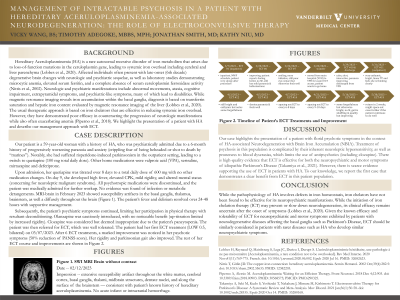Neurocognitive Disorders, Delirium, and Neuropsychiatry
Session: Poster Session
(110) Management of Intractable Psychosis in a Patient with Hereditary Aceruloplasminemia-associated Neurodegeneration: The Role of Electroconvulsive Therapy

Trainee Involvement: Yes

Vicky Wang (she/her/hers)
Medical Student
Vanderbilt University Medical Center
Nashville, Tennessee, United States- TA
Timothy Adegoke, MBBS, MPH.
Clinical Fellow
Vanderbilt University Medical Center
Nashville, Tennessee, United States - KN
Kathy Niu, MD
Assistant Professor
Vanderbilt University Medical Center
Nashville, Tennessee, United States .jpg)
Jonathan Smith, MD
Medical Director, VUAH Psychiatric Services; Fellowship Director
Vanderbilt University Medical Center
Nashville, Tennessee, United States
Presenting Author(s)
Co-Author(s)
Case Description: Our patient is 59-year-old female with a history of HA, who was psychiatrically admitted due to a 6-month history of progressively worsening paranoia and anxiety (crippling fear of being beheaded or shot to death by “marines”). Notably, she had suffered risperidone-induced parkinsonism in the outpatient setting, leading to a switch to Quetiapine (100 mg total daily dose). Other home medications were Valproic Acid (VPA), Sertraline, Mirtazapine and Deferiprone. Upon admission, her Quetiapine was titrated over 8 days to a total daily dose of 600 mg with no other medication changes. On day 9, she developed high fever, elevated CPK, mild rigidity and altered mental status (concerning for Neuroleptic Malignant Syndrome). All psychotropic medications were discontinued, and patient was medically admitted for further workup. No evidence was found for infection or metabolic derangements. MRI-brain showed “susceptibility artifacts” involving the basal ganglia, thalamus, and brainstem. Patient’s fever and delirium resolved over 24-48 hours with supportive management. Subsequently, patient’s psychiatric symptoms re-emerged, limiting her participation in physical therapy with resultant deconditioning. Olanzapine was cautiously introduced, with no noticeable benefit (up-titration limited by increased rigidity). Clozapine was considered but deemed inappropriate due to intercurrent pancytopenia. Patient was then referred for ECT, which was well tolerated. After 6 ECT treatments, a marked improvement was noticed in her psychotic symptoms (75% reduction of PANSS score). Her rigidity and parkinsonian gait also improved. Takamiya A, Seki M, Kudo S, Yoshizaki T, Nakahara J, Mimura M, Kishimoto T. Electroconvulsive Therapy for Parkinson's Disease: A Systematic Review and Meta-Analysis. Mov Disord. 2021 Jan;36(1):50-58. doi: 10.1002/mds.28335. Epub 2020 Oct 14. PMID: 33280168.
Background: Hereditary Aceruloplasminemia (HA) is a rare autosomal recessive disorder of iron metabolism which often causes late-onset (6th decade) degenerative brain changes with neurologic and psychiatric sequelae. (Lobbes, et al., 2020). We highlight the presentation of a patient with HA and describe our management approach.
Discussion: Our case highlights the presentation of a patient with florid psychotic symptoms in the context of HA-associated Neurodegeneration with Brain Iron Accumulation (NBIA). Treatment of psychosis in this population is complicated by their inherent neuroleptic hypersensitivity, as well as proneness to blood dyscrasias which limits the use of antipsychotics (including clozapine). There is high-quality evidence that ECT is effective for both the neuropsychiatric and motor symptoms of idiopathic Parkinson’s Disease (Takamiya et al., 2021). However, there is a dearth of evidence supporting the use of ECT in patients with HA. We report the first case to our knowledge that demonstrates clear benefit from ECT in this patient population.
Conclusions: Given the known efficacy and tolerability of ECT for neuropsychiatric and motor symptoms exhibited by patients with neurodegenerative diseases affecting the basal ganglia such as Parkinson’s Disease, ECT should be similarly considered in patients with rarer diseases such as HA who develop analogous neuropsychiatric symptoms.
References:
Lobbes H, Reynaud Q, Mainbourg S, Lega JC, Durieu I, Durupt S. [Aceruloplasminemia, a rare condition not to be overlooked]. Rev Med Interne. 2020 Nov;41(11):769-775. French. doi: 10.1016/j.revmed.2020.06.002. Epub 2020 Jul 16. PMID: 32682623.

